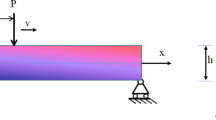Abstract
This paper describes the non-linear identification of a progressively damaged reinforced concrete beam-column node. The aims are the detection and identification of the different sources of damping and their dependence from the damage level. To this end a specially formulated non-linear identification method is proposed, based on a time-varying polynomial approximation of the system dynamics, suitable for use in the presence of excitations of any form. A minimum condition imposed to the identified dissipated energy leads to the distinction of the linear viscous component from the other damping mechanisms. The estimated values obtained from the experimental tests show a significant influence of the damage level on the linear viscous damping coefficient. This suggests that, in a non-linear dynamic time-history analysis, the use of Rayleigh damping model with proportionality to the initial stiffness is basically in contrast with experimental evidence and more refined viscous damping models are needed for prediction purposes.












Similar content being viewed by others
References
Dieterle R, Bachmann H (1981) Experiments and models for the damping behaviour in vibrating reinforced concrete beams in the uncracked and cracked condition. IABSE Reports of the Working Commissions 34:69–82
Mahrenholtz O, Bachmann H (1991) Vibration problems in structures—practical guidelines. CEB Bulletin d’information 209:169–180
Hall JF (2006) Problems encountered in the use (or misuse) of Rayleigh damping. Earthq Eng Struct D 35:525–545. doi:10.1002/eqe.541
Léger P, Dussault S (1992) Seismic-energy dissipation in MDOF structures. J Struct Eng-ASCE 118(5):1251–1269. doi:10.1061/(ASCE)0733-9445(1992)118:5(1251)
Petrini L, Maggi C, Priestley MJN, Calvi GM (2008) Experimental verification of viscous damping modeling for inelastic time history analyzes. J Earthquake Eng 12(S1):125–145
Priestley MJN, Grant DN (2005) Viscous damping in seismic design and analysis. J Earthquake Eng 9(SP2):229–255
Sohn H, Farrar CR, Hemez FM, Shunk DD, Stinemates DW, Nadler BR (2003) A review of structural health monitoring literature: 1996–2001. Los Alamos National Laboratory Report, LA-13976-MS
Lazan BJ (1968) Damping of materials and members in structural mechanics. Pergamon, Oxford
Adhikari S (2007) On the quantification of damping model uncertainty. J Sound Vib 306:153–171. doi:10.1016/j.jsv.2007.05.022
Ceravolo R (2004) Use of instantaneous estimators for the evaluation of structural damping. J Sound Vib 274:385–401. doi:10.1016/j.jsv.2003.05.025
Chen S-L, Liu J-J, Lai H-C (2009) Wavelet analysis for identification of damping ratios and natural frequencies. J Sound Vib 323:130–147. doi:10.1016/j.jsv.2009.01.029
Woodhouse J (1998) Linear damping models for structural vibration. J Sound Vib 215(3):547–569. doi:10.1006/jsvi.1998.1709
Salzmann A (2002) Damping characteristics of reinforced and prestressed normal and high-strength concrete beams. Dissertation, School of Engineering, Faculty of Engineering and Information Technology, Griffith University, Australia
Salzmann A, Fragomeni S, Loo YC (2003) The damping analysis of experimental concrete beams. Adv Struct Eng 6(1):53–64. doi:10.1260/136943303321625739
Aoki T, Sabia D, Yuasa N, Rivella D, Muto H (2005) Dynamic identification of RC building No.5 of the college of industrial technology at Nihon University. In: Proceedings of Tenth International Conference on Civil, Structural and Environmental Engineering Computing. Rome, Italy
Curadelli RO, Riera JD, Ambrosiani D, Amani MG (2008) Damage detection by means of structural damping identification. Eng Struct 30:3497–350. doi:10.1016/j.engstruct.2008.05.024
Ndambi JM, Peeters B, Maeck J, De Visscher J, Wahab MA, Vantomme J, De Roeck G, De Wilde WP (2000) Comparison of techniques for modal analysis of concrete structures. Eng Struct 22:1159–1166. doi:10.1016/S0141-0296(99)00054-1
Flesch R (1981) The damping behaviour of R/C cantilever elements. IABSE Reports of the Working Commissions 34:83–98
Chowdhury SH, Loo YC, Fragomeni S (2000) Damping formulae for reinforced and partially prestressed concrete beams. Adv Struct Eng 3(4):327–335
Chowdhury SH, Loo YC (2003) Logarithmic decrement of damping xin reinforced and partially prestressed concrete beams—new prediction formulas. In: Proceedings of International Conference on Advances in Structures, Steel, Concrete, Composite and Aluminium (ASSCCA ’03), pp. 569–573. Sydney, Australia
Modena C, Sonda D, Zonta D (1999) Damage localization in reinforced concrete structures by using damping measurements. In: Proceedings of the International Conference on Damage Assessment of Structures (DAMAS 99): 132–141. Dublin, Ireland
Zonta D, Modena C, Bursi OS (2000) Analysis of dispersive phenomena in damaged structures. In: Proceeding of European COST F3 Conference on System Identification and Structural Health Monitoring, Spain, pp. 801–810
Kyprianou A, Worden K, Panet M (2001) Identification of hysteretic systems using differential evolution algorithm. J Sound Vib 248(2):289–314. doi:10.1006/jsvi.2001.3798
Smyth AW, Masri SF, Kosmatopoulos E, Chassiakos AG, Caughey TK (2002) Development of adaptive modelling techniques for non-linear hysteretic systems. Int J Nonlinear Mech 37:1435–1451. doi:10.1016/S0020-7462(02)00031-8
Benedettini F, Capecchi D, Vestroni F (1995) Identification of hysteretic oscillators under earthquake loading by nonparametric models. J Eng Mech-ASCE 121:606–612. doi:10.1061/(ASCE)0733-9399(1995)121:5(606)
Masri SF, Caffrey JP, Caughey TK, Smyth AW, Chassiakos AG (2004) Identification of the state equation in complex non-linear systems. Int J Nonlinear Mech 39:1111–1127. doi:10.1016/S0020-7462(03)00109-4
Pei J-S, Smyth AW, Kosmatopoulos E (2004) Analysis and modification of Volterra/Wiener neural networks for the adaptive identification of non-linear hysteretic dynamic systems. J Sound Vib 275:693–718. doi:10.1016/j.jsv.2003.06.005
Ceravolo R, Demarie GV, Erlicher S (2007) Instantaneous identification of Bouc-Wen-type hysteretic systems from seismic response data. Key Eng Mat 347:331–338. doi:10.4028/www.scientific.net/KEM.347.331
Tobita J (1996) Evaluation of nonstationary damping characteristics of structures under earthquake excitation. J Wind Eng Ind Aerod 59:283–298. doi:10.1016/0167-6105(96)00012-8
Worden K, Tomlinson GR (2001) Nonlinearity in structural dynamics. Detection, identification and modelling. Institute of Physics, Bristol
Park Y, Ang A (1985) Mechanistic seismic damage model for reinforced concrete. J Struct Eng-ASCE 111(4):722–739. doi:10.1061/(ASCE)0733-9445(1985)111:4(722)
Peng ZK, Tse PW, Chu FL (2005) An improved Hilbert-Huang transform and its application in vibration signal analysis. J Sound Vib 286:187–205. doi:10.1016/j.jsv.2004.10.005
Salvino LW (2000) Empirical mode analysis of structural response and damping. In: Proceedings of IMAC-XVIII: 503–509. San Antonio, Texas
Yang JN, Ying L, Pan S, Huang N (2003) System identification of linear structures based on Hilbert-Huang spectral analysis. Part 1: normal modes. Earthq Eng Struct D 32:1443–1467. doi:10.1002/eqe.287
Author information
Authors and Affiliations
Corresponding author
Rights and permissions
About this article
Cite this article
Demarie, G.V., Sabia, D. Non-linear Damping and Frequency Identification in a Progressively Damaged R.C. Element. Exp Mech 51, 229–245 (2011). https://doi.org/10.1007/s11340-010-9360-4
Received:
Accepted:
Published:
Issue Date:
DOI: https://doi.org/10.1007/s11340-010-9360-4




